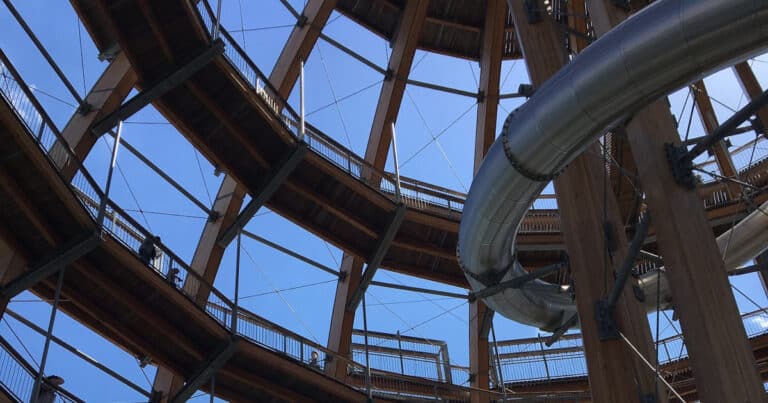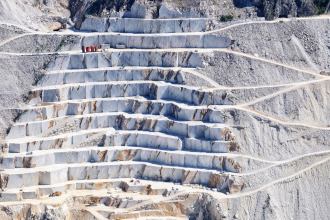By Matthew Mausner – What does it mean to have sustainable architecture? How can we create buildings and infrastructure in ways that both serve human needs, and yet minimize the total human impact to the environment?
Sustainable Design Principles
The easiest, maybe intuitive and most natural way to build sustainable architecture was, and still is, a process of Vernacular architecture or ‘Architecture without Architects’ (Rudofsky 1964) whereby a community builds its own shelters and houses, using shared local knowledge, methods and labor using local materials and techniques.
Eco-Friendly Principles of Sustainable Architecture
In those cases, one can aspire to the most eco-friendly and cutting edge design principles, building materials, energy consumption (where possible using renewable energy systems), sited appropriately in the environment, and respecting the surrounding natural environment.
Strategies that take advantage of circular economics, such as composting, passive heating and cooling, efficient heating and cooling systems, LEED incentives (Leadership for Environmental and Energy Design- a rubric used for sustainable design features), and more, can all influence and improve the sustainability of your structures.
The Challenges of Adapting to Sustainability Principles
There are all too few places in our generally densely populated world where brand new cities can be built, where on both a macro and micro scale sustainable design principles can be ideally applied. Most architectural projects happen in the context of an already built up environment, with a wide range of existing constraints of infrastructure and regulation.
Repurposing and recycling are critical to construction in most modern cities. Environmental geologists and engineers have to get involved before even the architects do, with phase 1 and phase 2 site assessments, soil remediation, and sometimes replacing or gutting or reconstructing the foundation of the construction site before anything else can happen on the project.
Building Materials for Sustainable Architecture
Once there is an opportunity to build anew, then plans can be drawn up that incorporate sustainable design principles, and choosing your materials appropriately is a central element. An important factor to keep in mind for the construction of buildings is resource transportation. Sending materials like bricks, wood, and steel via land or sea will emit a lot of greenhouse gases.
Where there is locally grown wood and it’s appropriate for the environment, like in the Pacific Northwest or in many South American countries, then wood can be an excellent choice.
Recycled materials like the magnificent hardwoods from Indonesia that were used in old Dutch Batavian villas can have a lifespan of hundreds of years even in a wholly new building there. Concrete with locally quarried rock can last a long time, especially with newer innovations in blends and composites. Well insulated materials have various benefits for the efficiency of the building with respect to heating and cooling as well.
Two Main Questions of Green Architecture
- How the materials affect the environment in the production process. Concrete, for example, is very polluting and uses lots of energy.
- How the materials affect the environment during their life span and later after their disposal. For example, can they be re-used, recycled or re-composited into other building materials?
Location in Sustainable Architecture
A critical aspect of sustainable architecture is the location of it and how that relates to its use, to the larger city or area it sits in, and to the environment. One can imagine, for example, a stand-alone skyscraper made from the newest eco-friendly materials, with solar panels and wind power generation and appropriately facing south for maximum passive heating and cooling, and a very high LEED score.
Yet, if this skyscraper is sited in a suburban office park, where every single person who uses it drives there in single-occupancy cars with long commutes, its net impact on the environment will be negative.
Adapting the Architecture to the Location
Similarly, a building design technique that works excellently in one location may work poorly in another. Innovative use of concrete in a set of building projects at a university Phoenix, AZ created its own ‘local wind’ on the campus and between the buildings, helping cool people in the hot dry climate.
That architecture was replicated in a university campus in Albany, NY- and was discovered to be a disaster in the cold, windy winter, literally driving people underground to avoid the bitterly cold winds that were amplified by the concrete design, and generating massive problems as students used maintenance tunnels underground!
Any approach to sustainability must take such considerations into account.
Formal Ways to Measure Sustainability
LEED is only one of many rubrics used by municipalities, countries, and architects to measure and balance the aspects of sustainable architecture and its related tradeoffs. Green building codes in many places such as San Francisco, CA and Copenhagen, Denmark are considered among the most comprehensive and progressive.
Factors That Influence Sustainable Architecture
These factors range from energy considerations, to the existing built environment, the sensitivity of the regional natural environment, the local air circulation and pollution patterns, other nearby construction age and use of materials, to the broader values of the community.
These scores are used to incentivize every architect to build sustainability considerations into their plans and cost from the start, and the net impact is therefore highly likely to be positive.
What is Driving Sustainable Architecture?
Our advancing scientific understandings of nature and the ecosystems, paired with discoveries of dozens of failed civilizations from humanity’s past and recent disasters such as the Aral Sea or the desertification of the Sahel in Africa, have made humans more aware of our collective vulnerability.
Our civilization, like every one that came before, is fragile and dependent on the earth’s environment. Sustainability is therefore an imperative.
Religion and Sustainable Architecture
Sustainability is deeply embedded in many religious traditions’ approaches to architecture. For example, Shahd Abu Sirryeh wrote in Sustainability Principles in Traditional Islamic Architecture about how Islamic buildings were designed with such factors as appropriate building materials, natural ventilation and similar factors in mind.
With modern features like centralized A/C, it can be tempting to abandon traditional architecture’s sustainable insights as unnecessary. However, recognizing the ecological crisis we face, we must integrate traditional architecture into our modern architecture to ensure a sustainable world for all of us.
* Featured image source







